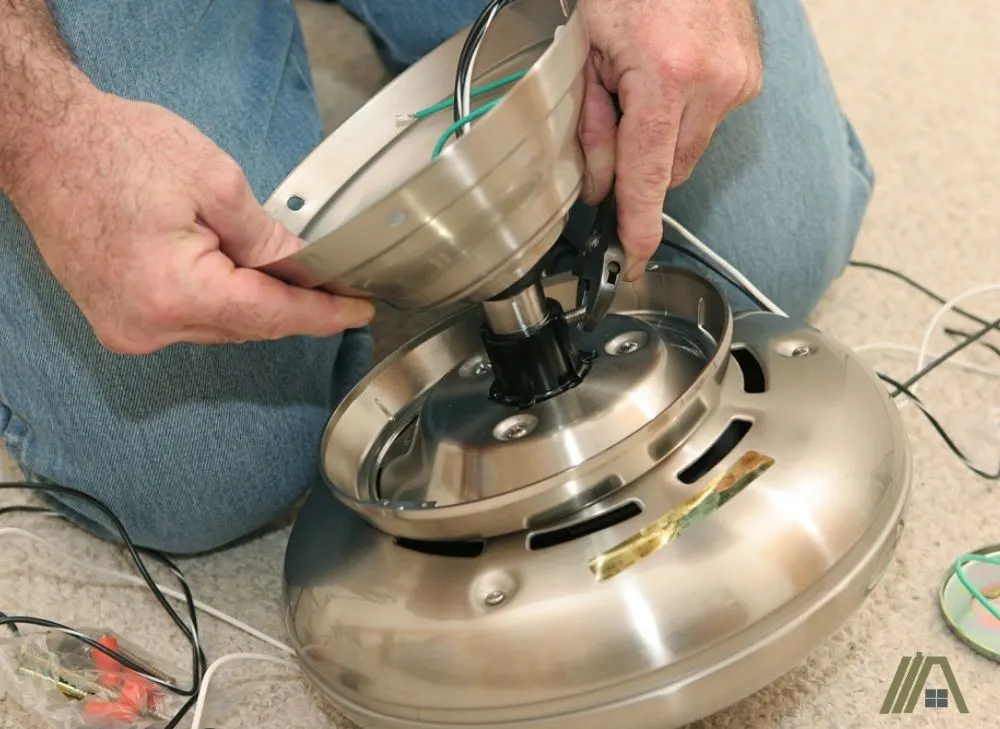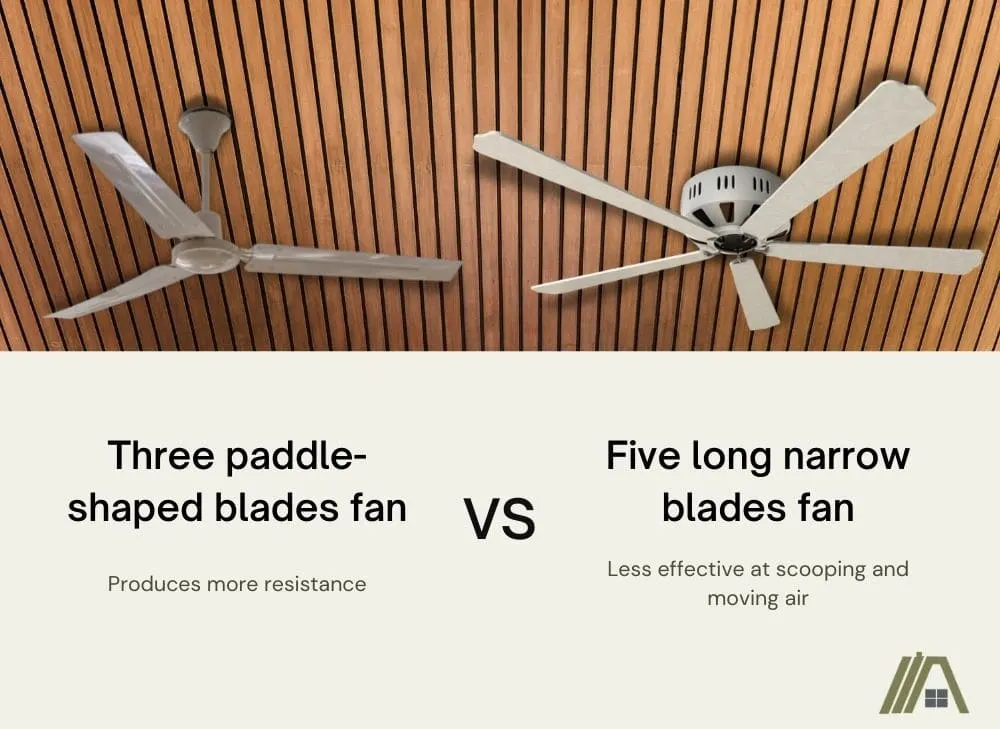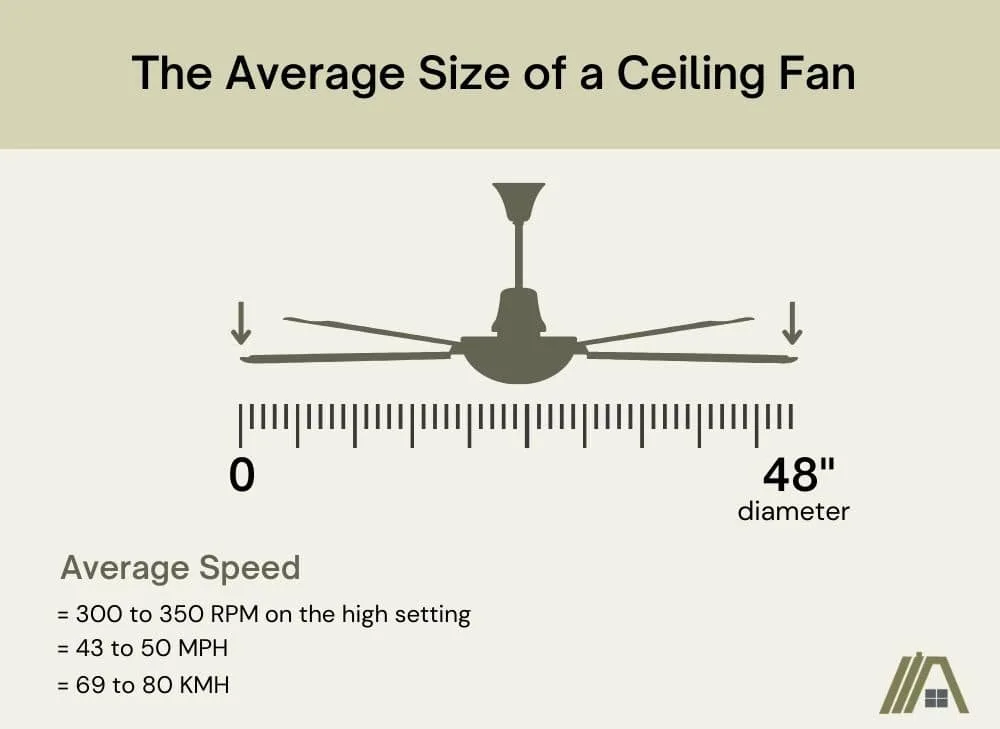Summer is on the way, and a ceiling fan is a great way to keep the air in a room circulating on those steamy hot days. Maybe you’ve wondered if your existing fan is still spinning as fast as it’s supposed to; we’ll show you how to find your answer.
We have the calculations to help you choose the right fan for your room and, as a bonus, a quick way to measure your ceiling fan speed quickly and accurately.

The average speed for a ceiling fan is 300-350 RPM, or 43-50 MPH, or 69-80 kmh. This can also be measured as mph or km/h, but the most common measure of fan speed is rpm. Fan speed is affected by the length of the blades, design, and size. Ceiling fans come in various sizes to suit different-sized rooms.
Ceiling Fan Speed Measured in RPM
A Ceiling fan’s blade speed is measured in rotations per minute, abbreviated as rpm, RPM, rev/min, or r/min.
RPM is an international unit of frequency used to indicate the number of revolutions at which something rotates around a fixed axis in a minute.
The international unit is used preferentially because it helps not to have to translate the speed of the fan into metric and imperial units depending on what country the fan is being shipped to. It also makes different models easily comparable.
Still, some people prefer imperial or metric measurement scales. The below calculations will allow easy conversions from RPM:
- Imperial, in MPH:
- Calculate fans circumference in miles = ((2 x π (3.142) x radius (inch) ÷ 63660)
- MPH = (Circumference in miles x RPM) x 60 (min)
- Metric, in kmh = (Constant 0.1885 x RPM) x Fan Diameter (m)
What Influences Ceiling Fan Speed?
Ceiling Fan Motor
The ceiling fan motor influences ceiling fan speed. Fundamentally, the more powerful the motor, the faster the fan blades can rotate, and the ideal size of the fan motor is determined by the power required to start the fan’s blades turning and keep the blades turning at the desired speed.
Fan motors are made in many different shapes and sizes and are either AC or DC powered. DC fan motors are up to 300 percent more efficient than AC motors of the same size.

Ceiling Fan Blades
The fan blades themselves impact the actual speed achieved by a motor of a certain size. They also impact the speed required for efficiency.
Ceiling blade size, shape, pitch, and number all influence ceiling fan speed and efficiency. This is because the blades create resistance.
Resistance is what forces air to flow, but the resistance also means that a motor of a certain capacity will be unable to reach the speeds it is capable of achieving without resistance.
We will look at each factor in isolation and assume a constant fan motor capacity in our observations. However, in reality, the interactions between all of these factors are complex and there is a “window” for which each relationship is true.
| Ceiling fan characteristic | Effect on speed | Effect on efficiency |
| Motor capacity | Greater capacity = greater speed | Greater capacity = greater efficiency |
| Blade length | Longer blades = lesser speed | Longer blades = greater efficiency |
| Blade shape | Paddle blades = lesser speed | Paddle blades = greater efficiency |
| Blade pitch | Greater pitch = lesser speed | Greater pitch = greater efficiency |
| Blade number | More blades = greater resistance | More blades = greater efficiency |
Actual Relationships Are More Complex
As an example of the actual complexity of relationships and the “window” in which the relationships are true, let’s look at blade number.
Yes, when you have more blades, you increase the surface area of the fan, thus increasing its resistance. However, if one fan has 3 paddle-shaped blades and you compare its resistance to a fan with 5 long and narrow blades, you might find that the 3-bladed fan produces more resistance.
Additionally, because the long, narrow blades are less effective at scooping and moving air, this fan may be less efficient, even though it has more blades.

Another example is that large-bladed fans tend to rotate at fewer revolutions per minute than smaller fans but retain their effectiveness at achieving good airflow due to the longer blades having increased blade tip speed.
What Is the Average Ceiling Fan Speed?
The speed at which ceiling fans spin is primarily determined by the manufacturer’s design. To maximize the fan versatility, most are fitted with a motor that has adjustable speed settings so that the airflow created is adaptable to the user’s preference.
The primary fan speeds are slow, moderate, and fast. The average fan speeds are, on average, as per the following:
- Slow: Up to 200 RPM
- Medium: Up to 300 RPM
- High: Up to 400 RPM
You get varying sizes of ceiling fans, but a 48″ fan (as measured from the tip of one blade to the tip of the opposite blade) is considered to be the average size and so the average speed at which it rotates can be seen as the average speed of a ceiling fan.
A 48″ diameter ceiling fan runs at a speed of 300 to 350 RPM on the high setting. This is around 43-50 MPH and 69-80 kmh.

RPMs for smaller fans may be higher because they typically have to rotate faster to achieve a certain efficiency of airflow. Larger fans will have smaller average RPMs because the longer the blades, the more efficient they are with fewer rotations.
Each manufacturer determines the actual speed for the fan design, so check the RPM rating when buying.
Maximum Permitted Speed for Ceiling Fans
UL standards regarding maximum fan speeds are pretty specific. UL 507 states that the maximum allowed speed of the fan blade tip is:
- 3200 ft/min (36.3 MPH or 58.5 kmh) for 3/16″ thick blades
- 2400 ft/min (27.2 MPH or 43.8 kmh) for 1/8″ thick blades
You shouldn’t have t worry about this, though. The fan would not be saleable if it contravened this standard.
Fan speeds are limited for safety reasons due to the blades being exposed. Accidental contact with a spinning blade can cause serious injury, so caution is advised.
When choosing a fan, keep in mind that faster is not always better. The design of the fan and the size also significantly affect its performance.
Also, the amount of noise is something to consider. The higher the number of blades a ceiling fan has, the more noise it’ll generate, and increasing the speed will further increase the noise produced.
Measuring the Speed of a Ceiling Fan
Measuring your ceiling fan’s speed can be easily done with an electronic, non-contact, handheld tachometer. The tachometer is a universal rotational measuring tool used to determine the rotations per minute for several items such as lathes, electric motors, fans, and more.
The Neiko 20713A (amazon link) digital tachometer available online is perfect for the job. Here’s how to measure your ceiling fan speed in a few easy steps.
- Make sure the fan is turned off.
- Cut a 1″ piece of reflector tape (which should be included with the tachometer).
- Stick the tape onto the outermost edge of one of the fan’s blades.
- Turn the ceiling fan on and allow it to reach the operating speed.
- Turn the tachometer on and point the indicator light at the end of the fan’s blades so the meter can pick up the reflector tape as it’s rotating (blades turn fastest on the outermost edge).
- The tachometer will display the reading in RPM.
- Stop the fan and remove the reflector tape.
References
https://physics.stackexchange.com/questions/86593/how-to-measure-speed-of-a-ceiling-fan
https://www.hunker.com/13711106/how-to-balance-a-ceiling-fan

